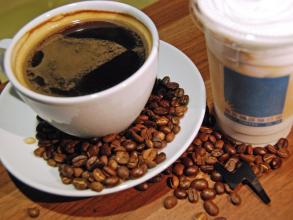Introduction to the method of brewing methods for describing the characteristics of grinding degree of Robusta coffee flavor
The output of Robusta species accounts for 25% of coffee bean production, which accounts for 25% of coffee bean production. Its main producing country is Indonesia (one of its coffee beans is a kind of coffee bean processed by washing method, which is a hybrid between Robusta and Arabica. It is the only coffee bean on the Chinese market that can be used as a single drink), Vietnam, Africa, (Ivory Coast, Nigeria, Angola as the center of the West African countries), Vietnam has been more committed to coffee production in recent years, and included it in national policy (Vietnam also produces a small number of Arabica coffee beans) Robsta coffee tree is a kind of tree between shrubs and tall trees with longer leaves. The color is bright green, the tree can be up to 10 meters high, but the root is very light, the fruit is slightly rounder and smaller than Arabica coffee, the bean body is flat and round, and the pit in the middle is straight.
Robusta has a unique aroma (known as "Rob flavor", some people mainly because of musty smell) and bitterness. If 2% of the coffee is mixed with other coffee, the whole cup of coffee will become Rob flavor (therefore, Robusta coffee beans can not be drunk as individual coffee beans).
Its flavor is so bright and strong, but if you want to taste it directly, you have to be prepared.
In general, robusta coffee is used in instant coffee (which extracts about twice as much liquid as Arabica), canned coffee, liquid coffee and other industrial coffees.
Its caffeine content is much higher than that of Arabica species, about 3.2%.
Arabica coffee has harsh planting conditions, weak disease resistance, high altitude requirements, slow growth, high quality, and fine processing of raw beans. Arabica coffee beans are elegant and slender in shape, with large and uniform grains. Different producing areas have their own different flavor and aroma, rich taste and different taste. It makes it the only coffee among these original species that can be drunk directly and alone, and can be used as a single product or as an Italian blend of coffee.
Robusta coffee has the advantages of strong adaptability, easy planting, fast growth and high yield. in general, the treatment of raw beans is relatively extensive and low quality (there is also a small amount of washed refined robusta). Robusta coffee has a round and rugged shape, relatively small grains, mixed beans, bright and strong flavor, mainly bitter taste, and has a bad rubber taste or mildew smell because of its low level of raw bean treatment. most Robusta beans are not suitable for drinking as a single coffee, and a few Robusta beans are used as Italian ingredients. The proportion is very low (but it does not rule out the fact that very few high-quality Robbosa beans can reach more than half of them). In general, robusta coffee is used in instant coffee (which extracts about twice as much liquid as Arabica), canned coffee, liquid coffee and other industrial coffees. Its caffeine content is much higher than that of Arabica, about 3.2%.

Important Notice :
前街咖啡 FrontStreet Coffee has moved to new addredd:
FrontStreet Coffee Address: 315,Donghua East Road,GuangZhou
Tel:020 38364473
- Prev

Guatemala La Cadura Coffee Flavor Description Grindness Characteristics Variety Producing Area Taste Introduction
Mainly cultivated on Java Island, Indonesia, drought and insect tolerance; bitter taste, but bitter with fragrance, especially after cooling with a unique sweet taste, suitable for cold coffee, is full-bodied and extremely bitter. Leberica: This variety is very rare, mostly used to synthesize coffee and make coffee extract, rarely seen on the market, poor quality, poor flavor of individual products Guatemala
- Next

Description of Arabica Coffee Flavor, characteristics of Grinding degree, introduction to brewing method
Arabica with the difference between market price and use? Coffee requires a complicated process of hand picking, selection and fine processing, so are the most expensive and best coffee beans in the world? Arabica? Grow coffee. Robusta? Caffeine is low-cost and is usually used to produce instant coffee and canned coffee. A few of the better ones? Robusta? Growing coffee is also used in blending.
Related
- Detailed explanation of Jadeite planting Land in Panamanian Jadeite Manor introduction to the grading system of Jadeite competitive bidding, Red bid, Green bid and Rose Summer
- Story of Coffee planting in Brenka region of Costa Rica Stonehenge Manor anaerobic heavy honey treatment of flavor mouth
- What's on the barrel of Blue Mountain Coffee beans?
- Can American coffee also pull flowers? How to use hot American style to pull out a good-looking pattern?
- Can you make a cold extract with coffee beans? What is the right proportion for cold-extracted coffee formula?
- Indonesian PWN Gold Mandrine Coffee Origin Features Flavor How to Chong? Mandolin coffee is American.
- A brief introduction to the flavor characteristics of Brazilian yellow bourbon coffee beans
- What is the effect of different water quality on the flavor of cold-extracted coffee? What kind of water is best for brewing coffee?
- Why do you think of Rose Summer whenever you mention Panamanian coffee?
- Introduction to the characteristics of authentic blue mountain coffee bean producing areas? What is the CIB Coffee Authority in Jamaica?

